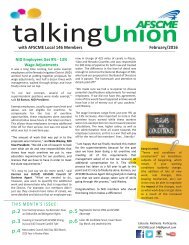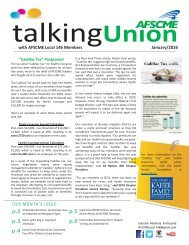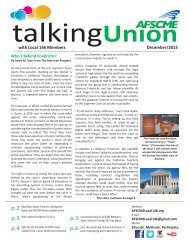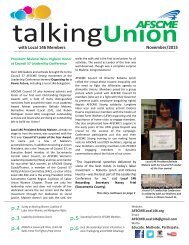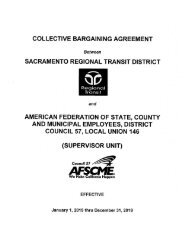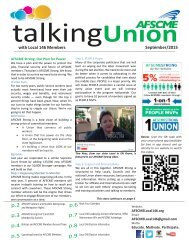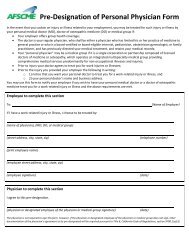STEWARD HANDBOOK
You also want an ePaper? Increase the reach of your titles
YUMPU automatically turns print PDFs into web optimized ePapers that Google loves.
If the answer to any of these questions is “yes,” there is a good chance that a<br />
grievance may exist.<br />
Past Practice<br />
In general, a past practice is not covered in the contract but, over time, has<br />
come to be accepted as an employment condition. To cite “past practice,”<br />
these four elements must be present:<br />
A Clear and Consistent Course of Conduct: The practice has to be<br />
normal activity. A “past practice” is not a vague activity or an occasional<br />
lapse in the usual way of doing business.<br />
Activity Over a Reasonable Duration: The phrase “reasonable duration”<br />
is subjective and indefinite. Arbitrators decide – on a case-by-case<br />
basis – whether a practice has gone on “long enough” to be considered a<br />
condition of employment. One or two occurrences a year won’t be considered<br />
consistent over a reasonable duration. However, the same activity<br />
repeated once a week for five years might be.<br />
Full Knowledge: Both parties, management and the union, must know<br />
the practice exists. This does not have to be officially stated or recognized,<br />
but it does have to be verified.<br />
The Contract Is Silent or Ambiguous: When the contract is silent on the<br />
activity, the practice may be considered to be an implied term of the contract<br />
if all of the above elements are present. Where contract language is vague or<br />
ambiguous, it is implied the two parties intended the activity to be covered<br />
by the contract. Arbitrators look to the past practice to determine the intent<br />
of the contract.<br />
In addition, the union must demonstrate that harm was done to affected<br />
employees by management’s changing the practice.<br />
An Example of Past Practice<br />
Scenario: At a state hospital, the workday in the Grounds Department ends<br />
at 4:30 p.m. Every day at 4:15, the workers return to the building where the<br />
tools and equipment are kept. The supervisor’s office is also located there.<br />
The workers clean up before they punch out for the day and go home. Though<br />
there is no language in the contract covering “wash-up time,” this practice has<br />
continued for as long as anyone can remember.<br />
Conclusion: All four past practice elements are in place – consistent activity,<br />
lengthy duration, knowledge of the parties and a silent contract. Should<br />
management decide to change the practice, the union would have solid grounds<br />
for filing a grievance based on past practice.<br />
25



